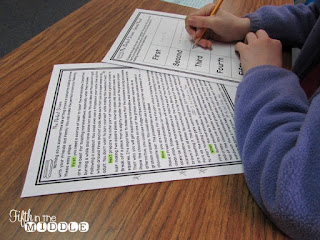



I prefer to write directly on the paper, but if you're using a textbook, novel, or whatever, that obviously isn't a good idea. So if I'm using a story from Wonders, I hand out small Post-It notes students can use instead. Or sometimes I'll photocopy the selection from the book, like maybe just the page about Harriet Tubman. And I saw this really cool idea on Pinterest. Genius.
After annotating during the cold read, we have a class discussion about the selection - what annotations did you make and why? There are no wrong answers during this part since everyone will have different thoughts and connections with the text. The discussion lasts anywhere from 10-20 minutes, depending on how thought-provoking the text was. Sometimes we just share with a partner instead. I like to mix it up just to keep things interesting and fresh. The point is to just get them talking and listening to each other about the topic.

On the second day, I ask some sort of question that requires them to independently practice going back to the text to answer. Maybe I want them to compare/contrast, look for particular details, answer the who/what/where questions, or put some events in sequential order. We are digging slightly beyond the initial reading and are starting to get some understanding of the text. If they have a print copy, then I'm asking them to highlight where they found the answers. I have found that I get more participation if they get to use highlighters, Post-Its, or whatever. For my class, this takes about 15 minutes.
On the third day, we take another look at the text. This time, I'm asking a question about the structure, vocabulary, figurative language, author's voice, or something else that doesn't necessarily focus on the text and details. Maybe we outline the selection looking for main ideas and supporting details. If we are using the print copies, this is the day we underline our text evidence. So up to this point, our papers have annotations, highlights, and underlines. By now, it's pretty obvious who needs some extra attention because their paper is either empty or completely covered with highlighter and underlines. This also takes about 15 minutes.
The last activity I ask them to do with the selection is a short writing prompt. I pose a question that has something to do with the text and hopefully makes them use what they learned to answer it. I like asking questions about how ideas apply to their own lives, their opinions about something in the text, or maybe even a time when they experienced something similar. This is where I introduce how to quote directly from a text in their writing. I allow about 15-20 minutes for this part.
Notice that I'm not spending hours on this every day. This is why my students don't mind coming back to the same text day after day. This is also why it's so important to have an interesting selection (which is why I don't do it with every chapter in the textbook). In my opinion, it's also why close reading is so flexible in that you can do it whole class, in small groups, as independent work, or even as homework.Below are some free close reading topics that you can do with your students if you want to try these strategies without having to come up with your own text selections and questions.
These are my paid close reading products if you want to try it for a month or longer.

















I love teaching close reading and am excited to have some new passages!
ReplyDeleteThank you, Amy! This is a great post on Close Reading.
ReplyDelete